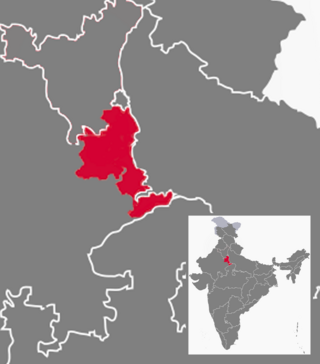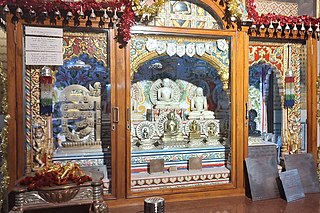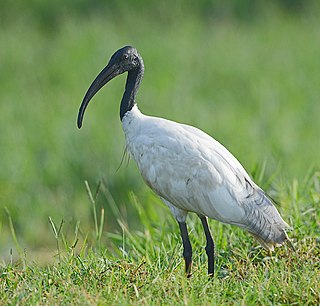
Gurgaon, officially named Gurugram, is a satellite city and administrative headquarters of Gurgaon district, located in the northern Indian state of Haryana. It is situated near the Delhi–Haryana border, about 30 kilometres (19 mi) southwest of the national capital New Delhi and 268 km (167 mi) south of Chandigarh, the state capital. It is one of the major satellite cities of Delhi and is part of the National Capital Region of India. As of 2011, Gurgaon had a population of 876,969.

The Aravalli Range is a mountain range in Northern-Western India, running approximately 670 km (420 mi) in a south-west direction, starting near Delhi, passing through southern Haryana, Rajasthan, and ending in Ahmedabad Gujarat. The highest peak is Guru Shikhar on Mount Abu at 1,722 m (5,650 ft). The Aravalli Range is arguably the oldest geological feature on Earth, having its origin in the Proterozoic era.

Mewat is a historical and cultural region which encompasses parts of the modern-day states of Haryana, Rajasthan, and Uttar Pradesh in north-western India.

Nuh district is one of the 22 districts of Haryana in northern India. The district is known for having the largest Muslim population in Haryana.

Nuh (Hind/Urdu: [nũːɦ], is a city and administrative headquarters of the Nuh district, located in the state of Haryana within the National Capital Region of India. It lies on the National Highway 248, also known as the Gurgaon-Sohna-Alwar highway, about 45 kilometres from Gurgaon.
Sohna is a town and a municipal council in the Gurugram district of Haryana, India. A popular tourist weekend and conference retreat, it is on the highway from Gurugram to Alwar near a vertical rock. Sohna is known for its hot springs and Shiva temple. Sohna tehsil is part of Ahirwal Region. Major communities in Sohna are Rajputs, Ahirs, Gujars, Jats, and Muslim Gujjar. Gurugram district is divided into 4 sub-divisions each headed by a Sub-Divisional Magistrate (SDM): Gurugram, Sohna, Pataudi and Badshahpur.

Haryana, formed on 1 November 1966, is a state in North India. For the administrative purpose, Haryana is divided into 6 revenue divisions which are further divided into 22 districts. For Law and Order maintenance, it is divided into 5 Police Ranges and 4 Police Commissionerates.
Badshapur is one of the 4 sub-division of Gurugram district of Haryana state, situated on the Gurugram-Sohna road (NH-248A). It is named after the Badshahpur Fort, which in turn was the abode of the wife of Mughal Emperor Bahadur Shah Zafar. Badshahpur is a part of Badshahpur assembly constituency of Haryana having majority of Rao Sahabs/Ahirs.
Bandhwari is a village dominated by Gurjar community in Gurgaon district in the Indian state of Haryana. It is an important biodiversity area contiguous to Asola Bhatti Wildlife Sanctuary within the Northern Aravalli leopard wildlife corridor. Bandhwari is also nicknamed the "strong village", because one in every three household has strongest boy in Bandhwari village
Silokhra is a village located in Gurugram city in the Gurugram district of Haryana, India. The village has a population of approximately 7715 individuals residing in around 1831 households. Although there are various castes living in the village, Brahmins make up the most significant demographic.

Jharsa is a village in Sector 39, Gurugram city of Gurugram district in Haryana State, India. It has a population of about 32,709; it is located 10 kilometres (6.2 mi) from the Gurugram city centre and 254 kilometres (158 mi) from the state's main city, Chandigarh. It is surrounded by Mohyal Colony, Patel Nagar, Kirti Nagar, Sectors 15, 31, 32, 39, 40, 46, and Indra Colony.
Teekli is a village in Sohna Mandal, Gurgaon District, Haryana state, India. It is 33.85 km south of India's capital New Delhi and lies in the foothills of the Aravali Mountains. It has a population of about 17,234 (approx) persons living in around 1,390 households. Teekli is dominated by Yadavs.

Asola-Bhati Wildlife Sanctuary covering 32.71 km2 area on the Southern Delhi Ridge of Aravalli hill range on Delhi-Haryana border lies in Southern Delhi as well as northern parts of Faridabad and Gurugram districts of Haryana state. Biodiversity significance of Ridge lies in its merger with Indo-Gangetic plains, as it is the part of the Northern Aravalli leopard wildlife corridor, an important wildlife corridor which starts from the Sariska National Park in Rajasthan, passes through Nuh, Faridabad and Gurugram districts of Haryana and ends at Delhi Ridge.

Damda reservoir in Sohna, near Gurugram city in Gurugram district in the Indian state of Haryana. Damdama Lake is a small lake in Haryana and was formed when a stone and earthen dam constructed by the British was commissioned for rain water harvesting in 1947. The lake, held by an embankment, is fed mainly by monsoon rain pouring into a trough at the base of the Aravali hills. The lake greets visitors with a water level down to 20 ft (6.1 m). During monsoon the water level reaches up to 50 ft (15 m) - 70 ft (21 m).
Forests Department, Haryana is a department of the Government of Haryana, a state in India, that runs and maintains many protected nature areas in the state of Haryana. It has two administrative divisions: Forest and Wildlife. The department is responsible for maintaining National Parks, Wildlife Sanctuaries and Conservation Reserves in Haryana. It also provides a special emphasis on Soil and Moisture Conservation works in the hills to conserve water and deliver it to adjacent farmlands. Two National Parks, eight Wildlife Sanctuaries, two Conservation Reserves, four Animal & Bird Breeding Centres, one Deer park, and 49 herbal parks. Kanwar Pal Gujjar has been the cabinet minister responsible for this department since October 2019. constitute the Protected Area network of the department, covering 0.75% of the state. It also maintains a list of Protected Areas in Haryana.

Basai wetland, located in Basai village in Gurgaon tehsil in Gurgaon district in Haryana, India, is a flora and fauna rich water body. It is recognised as one of India's Important Bird and Biodiversity Areas and is of global conservation significance as it supports populations of several endangered, vulnerable, and threatened bird species. Basai wetlandis recognised globally as an Important Bird Area (IBA) by the BirdLife International housing 20,000 birds of over 280 species including migratory birds and endangered birds, has not yet been declared a protected wetland by the Government of Haryana.
Pali is an Indian village in the NIT area of Faridabad city of Faridabad district under Faridabad Lok Sabha constituency of Haryana state, well known for being biggest crusher zone of Asia, that also has a seasonal waterfall. It is the part of the Northern Aravalli leopard wildlife corridor, an important wildlife corridor which starts from the Sariska National Park in Rajasthan, passes through Nuh, Faridabad and Gurugram districts of Haryana and ends at Delhi Ridge.

Aravali diversity-bio Park, Gurgaon, spreads over 153.7 hectares, near the Guru Dronacharya metro station in Gurgaon, Haryana, India. The park, contains ecologically restored and semi arid land vegetation. The park was opened to the public on World Environment Day, 5 June 2010. The park includes a number of trails and a native plant nursery and interpretive displays at the entrance. On 2022, the park was declared India's first OECM site- a tag given by the IUCN to areas that are not protected but support rich biodiversity. In April 2021, Municipal Corporation of Gurugram signed a Memorandum of Understanding (MOU) with Hero MotoCorp Ltd to maintain the park for 10 year.
Mangar Bani, a paleolithic archaeological site and sacred grove hill forest next to the Mangar village on Delhi-Haryana border; is in the South Delhi Ridge of Aravalli mountain range in Faridabad tehsil of Faridabad district in the Indian state of Haryana. It lies, immediate south of India's national capital Delhi, within NCR.

















